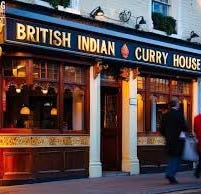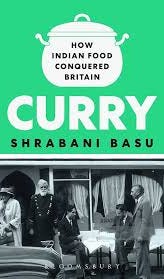Hola Global Jigsaw,
It was 1996 in Oxford, and I was a curry-house virgin. Amid the honey-gold colleges, church steeples and pubs, these establishments punctuated the town like exclamation points. Students congregated here in the evenings performing spice-tolerance in ordering their curry of choice: Bhuna (mild), Madras (medium) or Vindaloo (fiery).[1] With a side of Bombay potatoes. And maybe some bindi baji.
For an Indian student new to England, as I was, it was quite bewildering. What was this ontological universe where curry was a noun rather than an adjective, with a chili-based tripartite taxonomy? Where were the aspirated consonants? And what was a Bombay potato?
In India “curry” is not a dish and certainly not a synonym for our cuisine. It refers to the gravy that some dishes are cooked in, often, but not always, using a fragrant herb called, curry patta (leaf). The word itself is a British coinage, with a commonly held theory that dates to the 1886 Anglo-Indian phrase book, Hobson and Jobson, claiming that the word evolved from the Tamil, kari, which refers to a sauce or a relish to accompany rice.
In my undergraduate days in the 1990s, Indian food in the UK, even if not fully recognizable to me, was all the rage across the British isles. A 1997 Gallup poll concluded that “curry” was Britain’s favorite food, with over a quarter of the population eating it once weekly, at minimum. And stories that backed up the claim this was a nation of curryholics abounded in the media. There was, for example, the incident involving 10 Scottish football/soccer fans in Bordeaux. The fans were in France for a 1998 World Cup match. Unable to stomach football sans Indian food, they spent £600 on a takeaway order of curry and lager from the Eye of the Tiger restaurant in Bournemouth, and then a further £800 on a charter flight to deliver it.
A few years later in 2001, I was studying for an MSc in London, when the then British Foreign Secretary, Robin Cook, announced that the national dish of the UK was “chicken tikka masala.” This marked the public moment when the venerable fish and chips had been ousted by a colonial rival for the title. It was yet another deft example of reverse cultural flow from periphery to center, colony to metropole, taking its place along other British imports from India, like the words: shampoo, bungalow, pajama, jungle – all of which originated from Indian languages.
(For a primer on Indian English here is a link to an older piece in the Global Jigsaw:)
Cook’s political message in centering chicken tikka masala was to toot the horn of multicultural Britain, making the point that this dish, today so internationally synonymous with Indian food, had been created in Britain for British palettes, probably by a Bangladeshi cook. In this, the dish was merely part of a hoary tradition of national foods that have little to do with the nations they purport to come from: think the creamy version of Fettuccine Alfredo that was invented in the United States, or India’s famous “Chinese” Chicken Manchurian, that emerged from a kitchen in Bombay.
(Check out Global Jigsaw piece on the surprisingly global origins of food and the futility of culinary nationalism:)
Fast forward a couple of decades and as the journalist and author, Shrabani Basu’s updated version of her classic, Curry: How Indian Food Conquered Britain, makes clear, the days of the old curry-house have waned, to make way for trendy, regional, playful Indian restaurants that arguably make London, rather than Delhi or Bangalore, the international capital of modern Indian cuisine.
According to Basu’s book there are some 8,500 Indian restaurants in the UK today, visited by over 2 million people weekly. Some of these have won Michelin stars and even “the toughest, tattooed football fan- returning home from cheering his team in Old Trafford, knows his rogan josh from his lamb Madras.” Marks and Spencers, the quintessential British department store, serves 45 types of Indian dishes and Britons are estimated to eat 10 packs of the supermarket’s curry every minute.
About a decade ago my husband and I had visited a Michelin starred Indian restaurant in Knightsbridge, Amaya, on a weekend trip to London to celebrate our wedding anniversary. It turned out to be as distant an experience from the curry houses of my Oxford days as Madras the city is from Madras the British “curry sauce.” All the waiters were white Eastern Europeans and I chuckled as a Polish gent explained the Indian dishes to us in perfectly aspirated consonants, “This, is called baingan bHaji,” he explained earnestly.
Basu’s book is a romp through the history of Indian food’s relationship to Britain, from the days of European traders setting sail to look for spices in the East, to the arrival of Bangladeshi immigrants on British shores in the 1950s. Having honed their cooking skills onboard P&O ships[2], it was these Bangladeshis who started the first wave of curry houses, serving cheap curries suited to the British palate. According to the Bangladeshi Caterers Association the curry industry today, has an estimated annual turnover of 3.5 billion pounds and employs more people (mostly of Bangladeshi origin) than the total British workforce in steel and mines.
The naval connection to curry was also something that became evident to me when I lived in Japan. The Japanese Navy had a “Curry Friday” tradition where all navy canteens offered curry and rice as a Friday staple.
Ask the average person to guess Japan’s national dish and they’ll likely hazard sushi or soba. But, as I discovered, an equally fair contender for the title was curry. Japanese curry had only a superficial resemblance to its Indian ancestor, being more glutinous and often mixed with wheat flour. It was also sweeter, including ingredients like apple and honey, which would be plain weird in India.
In Japan, the dish dated to the 1870s when naval officers of the British Royal Navy who had picked up the curry habit in India passed it on to Japanese colleagues. The earliest recipes for raisu karī (rice curry) in Japanese cookbooks were lifted from Mrs Beeton’s Book of Household Management, in which the ingredients included curry powder, flour and sour apples. Since the dish came from Britain as far as the Japanese were concerned, curry rice was classified as “western” food.
More on this in a piece I wrote featuring a Bengali revolutionary and a cross-border love story, here
That’s all for this week. And now:
A request that is standard but no less urgent: please do become a paid subscriber. I depend on your patronage.
And please share the Global Jigsaw world with your friends.
Comments are always appreciated, so do drop me a line. I love hearing from you.
Hasta pronto,
Pallavi
[1] Bhuna is a style of cooking, Madras a city, and Vindaloo, a Goan dish, which made the British curry-house nomenclature particularly odd-sounding to me.
[2] P&O founders Brodie McGhie Willcox and Arthur Anderson began their business chartering ships to trade between the UK and Iberian ports in Spain and Portugal. During the Carlist wars of the 1830s, they supported the Spanish and Portuguese royal families by chartering steamers, transporting ammunition and raising loans. Such loyalty paid off. Willcox and Anderson earned political and commercial favour and the right to use the royal blue and white of the House of Braganza and the red and gold (yellow) of the Spanish Bourbons for their fledgling Peninsular Steam Navigation Company. A little piece of the Global Jigsaw






I loved your article! Since you ask, I had a great Lamb curry at Tandoori Station last week…..Question; do you have european restaurants in Delhi?
The Rash Behari Bose story is incredible. I'd heard of him when I was growing up in Calcutta (his name is attached to a major avenue) but had no idea about the Japan-curry angle.